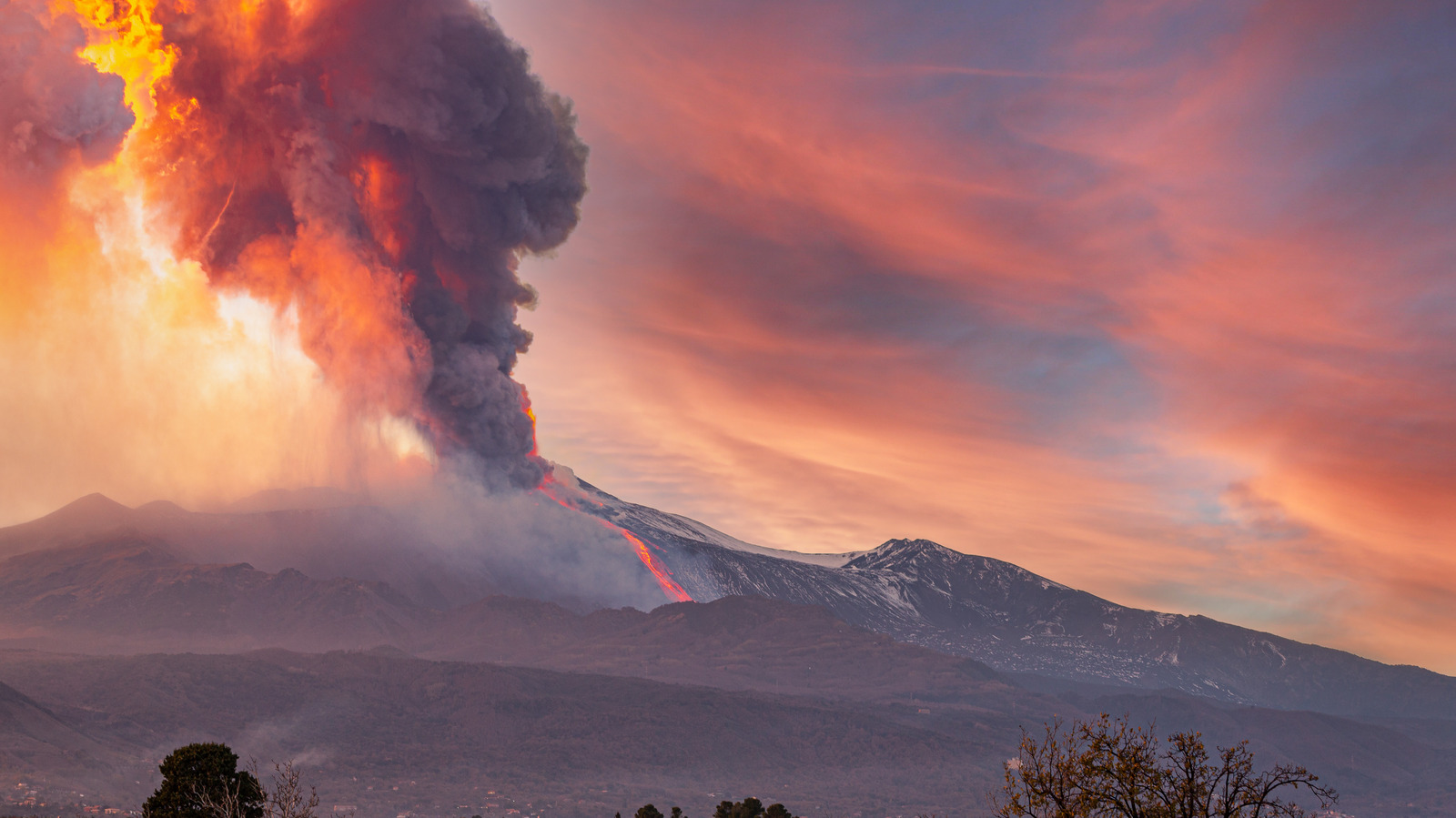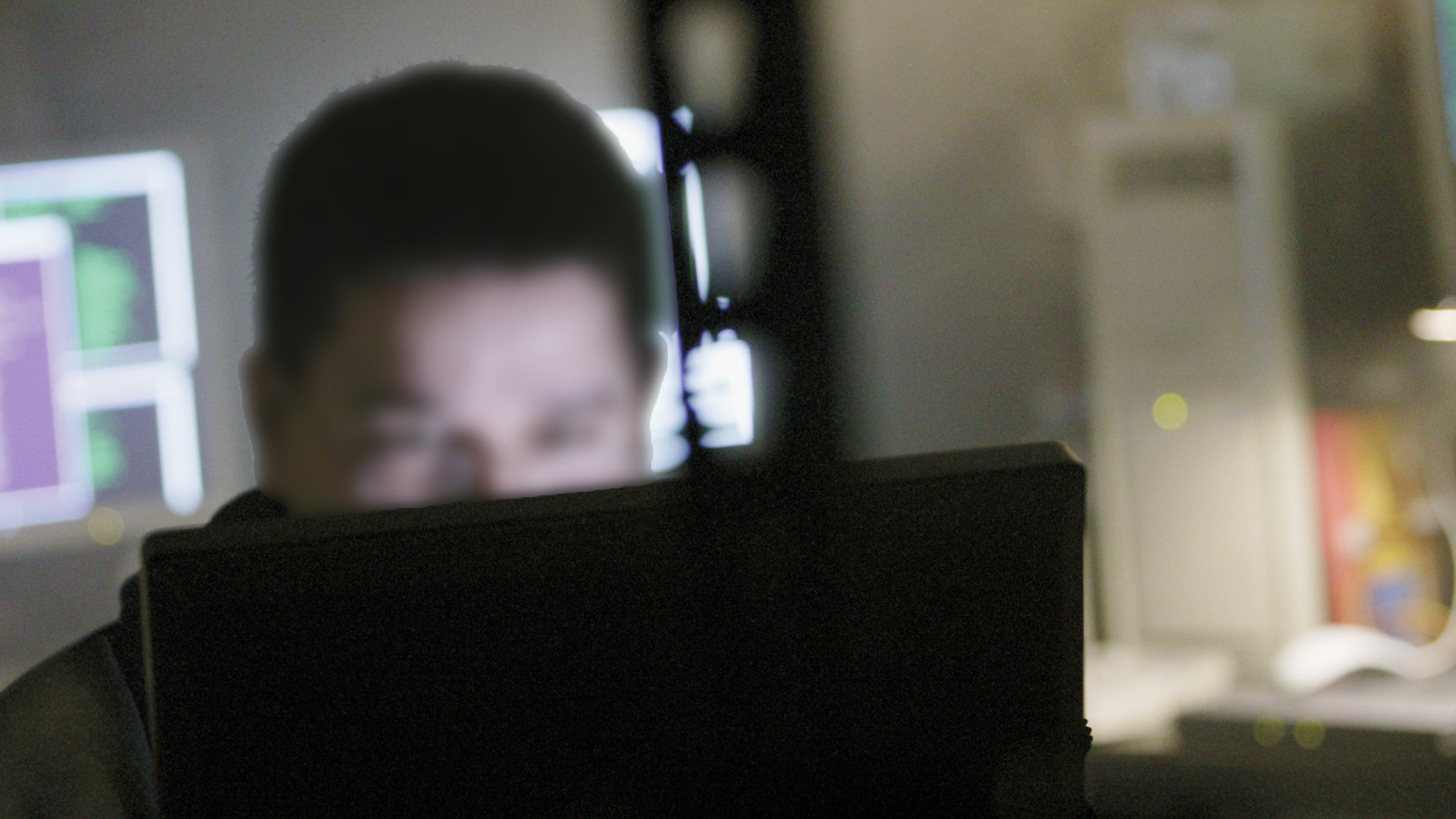
The Devastating Effects Of A Supervolcano Explosion Explained – Grunge
Defining a “supervolcano” isn’t easy. Some volcanologists, like Erik Klemetti writing for Wired, look down on the term that only took off after a 2005 documentary dramatized the aftermath of an eruption in Yellowstone National Park, naturally titled “Supervolcano.” Most deem something a supervolcano if it can potentially hit the top level of the Volcanic Explosivity Index (VEI) (an eight) and produce over 1,000 cubic kilometers (240 cubic miles) of material like volcanic ash.
Further adding to the confusion is the fact that supervolcanoes are not bound to erupt in devastating fashion. Broadly speaking, volcanic eruptions can be put on a scale from effusive to eruptive. So they can be relatively low-energy, like the ones that create large, sloping shield volcanoes such as Hawaii’s Kīlauea. Or they can have more explosive power, such as the destructive Plinian-type eruptions (named after Romans Pliny the Elder and Pliny the Younger, who respectively died in and recorded the A.D. 79 eruption of Mount Vesuvius).
But what if the worst-case scenario happened? What if an especially large supervolcano, such as the one sitting beneath the Yellowstone caldera in the western United States, were to suddenly and explosively erupt? The consequences of this event could be nothing short of disastrous and would affect humans the world over.
Numerous earthquakes could precede an eruption
 MuhsinRina/Shutterstock
MuhsinRina/Shutterstock
While it’s difficult to pin down the precise time that a volcano of any sort will erupt, certain precursors hint strongly at a coming blast. The movement of magma toward the surface can produce telltale signs like bulging ground surfaces, increased levels of gasses associated with volcanoes, and odd temperature changes. But perhaps the most dramatic symptom of all that would herald many a supervolcano eruption would be the earthquakes that would shift the ground in anticipation of a coming blast.
These wouldn’t be mild earthquakes, either. Increased activity in a large reservoir of magma could spell more frequent and more intense quakes, especially as all of that melted rock moves closer and closer to the surface. As USGS scientist Jacob Lowenstern told Vox, a pending supervolcano in a place like Yellowstone would produce a series of especialy intense earthquakes. That sort of activity wouldn’t just alarm everyone above, either. The tremors would also serve to break up the ground above the looming magma chamber, making it all the easier for the molten rock and pent-up gasses to reach the surface. Hopefully, this would also afford scientists the opportunity to warn the public and get an evacuation moving in time, though the movement of people away from danger would be a massive undertaking never before seen in history.
The initial blast would bring a deadly shockwave
 Masi Perez/Shutterstock
Masi Perez/Shutterstock
It’s hard to say just how a blast from a volcanic monster would turn out, but worst-case scenarios, things can get pretty spectacularly awful. Let’s consider the supervolcano currently sitting beneath Yellowstone National Park in the western U.S. If that magma chamber suddenly burst open, the shockwave emanating from the epicenter could be deadly. That pressure wave might kill 90,000 people alone.
While they aren’t as deadly as a gigantic supervolcano could prove to be, smaller eruptions hint at the sort of shockwaves that a big one could produce. In January 2022, a submerged volcano named Hunga Tonga-Hunga Ha’apai, located within the territory of Tonga, erupted. While it produced a large, deadly tsunami, the volcano also created a pressure wave so immense that it bounced around the Earth for days. Speaking with The New York Times, physicist Mark Boslough compared the wave to a staggeringly large sonic boom that encircled the planet, known to researchers as a “Lamb wave” after mathematician Horace Lamb. Previously recorded Lamb waves came courtesy of nuclear weapons testing. The last known volcano to have a similar worldwide effect was Indonesia’s Krakatau, whose 1883 eruption was so intense that sailors on a British ship 40 miles from the volcano suffered ruptured eardrums from the shockwave. The captain of that ship wrote that the blast was so immense he thought that perhaps Armageddon had occurred.
It could be astonishingly loud
 Parker & Coward/Wikimedia Commons
Parker & Coward/Wikimedia Commons
Some supervolcanoes could also prove to be intensely loud, as British sailors who suffered hearing damage after the 1883 Krakatau eruption learned the hard way. In fact, Indonesia’s Krakatau — also sometimes called Krakatoa — offers up some of the best real-world evidence of what a larger supervolcano might do to the hearing of people who are nearby.
The August 27, 1883, eruption of Krakatau was so earsplitting that it was within the range of human hearing, despite some witnesses being thousands of miles away. People typically reported that it sounded like large artillery firing in the distance. This is the longest a sound wave has been known to travel from its source to a human ear. As you may well guess, this meant that the Krakatau eruption was incredibly powerful, spewing forth material at supersonic speeds and obliterating its island. The tsunami generated by the explosion killed anywhere from just over 36,000 people to more than 120,000. The sound alone still stands at the loudest noise ever recorded.
Despite all this, Krakatau is not considered to be a supervolcano. Its explosivity index only comes in at a six on the VEI, while scientists generally agree that a supervolcano needs to reach the very top of the VEI at 8 to earn such a title. While a supervolcano could erupt more quietly, such as with an oozing lava flow, one that blasts forth as a violent Plinian eruption could be seriously loud.
Supervolcanoes can produce staggering amounts of lava
 Nikolay Zaborskikh/Shutterstock
Nikolay Zaborskikh/Shutterstock
Supervolcanoes are sitting on top of a lot of magma. Just how much depends on the volcano, though if all that molten rock made it to the surface, things could get seriously destructive regardless.
The Yellowstone caldera sits atop two large reservoirs of magma that have been observed using seismic waves generated by earthquakes rumbling through the ground. The closest magma chamber to the surface sits as little as three miles beneath the top and is an estimated 55 miles long by 25 miles wide. However, geologists originally estimated that, at most, only 15% of that rock is in melted magma form. A 2022 study in Science increased that number, concluding it was more like 20%. The lower magma chamber is more than four times larger and sits between 12 to 30 miles deep, but just 2% of its reserves appear to be melted. This still represents a tremendous amount of superhot molten rock, but it might not be the massive underground cauldron of your worst nightmares.
Still, that’s a lot of magma. Most estimates conclude that an Yellowstone eruption would make more than a square kilometer of lava. Multiple eruptions over the 640,000 years since the last major eruption filled the large crater once left by the region’s volcano, called a caldera. Though past lava flows have been fairly slow, one in today’s park would incinerate plants and buildings, cover roads, and make it all but impossible to access parts of Yellowstone.
A new caldera could collapse the landscape
 Yudhapohan/Wikimedia Commons
Yudhapohan/Wikimedia Commons
All of that lava, ash, superheated gas, and other material that can spew forth from a supervolcano has to come from somewhere. And while a plume of toxic material hurtling into the sky or along the slope is sure to catch your attention, it’s worth remembering the empty magma chamber left underneath the spewing volcano. During large eruptions that produce plenty of lava, that chamber quickly loses the support of the molten rock it once contained. Once it’s effectively become a hollow shell of rock, it might collapse in on itself, bringing anything on the surface down in a catastrophic tumble. The resulting massive depression in the landscape is known as a caldera.
Sometimes, calderas fill with water, creating large lakes that fishers and boaters might not realize were once the site of a humongous volcano. The Toba caldera in Indonesia is now a lake — in fact, it’s the largest known lake to have been formed by a volcano, containing more than 58 cubic miles of water and reaching as deep as 1,656 feet. Meanwhile, the biggest caldera anyone appears to have found is underwater, according to a 2020 paper published in Marine Geology. Known as the Apolaki Caldera, it sits in the Philippine Sea just north of the island of Luzon. It’s estimated to be a staggering 93 miles across. The eruption that formed this beast occurred at some point 41 million years ago.
[Featured image by Yudhapohan via Wikimedia Commons | Cropped and scaled | CC BY-SA 4.0]
Pyroclastic flows would create fast-moving devastation
 C.G. Newhall/USGS/Wikimedia Commons
C.G. Newhall/USGS/Wikimedia Commons
While there are plenty of things to worry about if you’re in the path of a volcano, one hazard is extra terrifying: pyroclastic flows. A pyroclastic flow is a mass of volcanic material (like ash, rock, and gas) that comes barreling down the side of a volcano at more than 50 miles per hour. Because this mass of material is often dense and can top 1,300 degrees Fahrenheit, anything (or anyone) in its path is pummeled and incinerated into oblivion.
The A.D. 79 eruption of Mount Vesuvius was deadly for many of the people of Herculaneum because of a superheated pyroclastic flow. A 2018 study published in PLoS One found that people sheltering in seaside boathouses had been hit by a sudden and intense wave of heat soon after the eruption. The authors concluded that people who had been sheltering in the boathouses were hit by a fast-moving pyroclastic flow. A 2020 study in Antiquity noted that some of these ancient disaster victims may have suffered a more lingering death, as the stone boathouses appear to have sheltered them from the immediate effects of the pyroclastic flow but could have heated up like ovens afterward.
Depending on the type of eruption, it stands that a supervolcano could produce enough explosive power and material to create an extra-deadly pyroclastic flow. This sort of onrush, if produced by the Yellowstone supervolcano for example, could extend as far as 62 miles from the epicenter of the eruption.
Heavy ash fall would cause chaos
 Árni Friðriksson/Wikimedia Commons
Árni Friðriksson/Wikimedia Commons
For those in the immediate area of a supervolcano eruption, hazards like shockwaves and pyroclastic flows are of immediate concern. But, destructive as they may be, these issues are over relatively quickly and can’t range incredibly far. Not so for the ash produced by a supervolcano, which can be blasted high into the atmosphere, allowing the material to spread out over a wide range. Volcanic ash contains sharp bits of material, making it tough and mildly corrosive. Because it becomes conductive when wet, ash can also disrupt electronics.
The sheer amount of ash can be a big deal, too. An eruption of the Yellowstone supervolcano could produce so much of it that structures would collapse under the weight as far out as 60 miles from the eruption. What’s more, the fine ash can enter air filters and vehicle engines, making it difficult to do anything other than stay put and watch the ash fall. This factor would obviously complicate evacuation efforts and attempts to bring supplies into the region.
According to a 2014 study published in Geochemistry, Geophysics, Geosystems, evidence of ancient Yellowstone eruptions indicates that volcanic material made it as far as the Gulf of Mexico. Depending on the length and intensity of a future eruption, practically everyone in the United States and its neighboring countries would be dealing with the widespread and disruptive ash.
[Featured image by Árni Friðriksson via Wikimedia Commons | Cropped and scaled | CC BY-SA 3.0]
Ash and sulfur dioxide can create health hazards
 Marco Ritzki/Shutterstock
Marco Ritzki/Shutterstock
Ash from a supervolcano presents a particular threat to human health. Fine, light volcanic ash can irritate your upper respiratory tract and can present extra problems for anyone with pre-existing breathing conditions like asthma. Ash can also scratch peoples’ eyes and sometimes even irritates the skin of sensitive people. Very fine ash with a high silica content can present an even bigger and more long-term problem. If a supervolcano were to erupt with this sort of ash, some people might breathe it in, where it can scar lung tissue and lead to a disease known as silicosis. No one’s been able to link silicosis cases to volcanic eruptions just yet, but a supervolcano eruption could present just such an unfortunate opportunity.
Then, there’s the problem of acid. Specifically, sulfuric acid, which can be produced when water in the atmosphere binds with sulfur dioxide gasthat’s belching out of a volcano. This can lead to a decrease in air quality that might set in motion long-lasting health issues. According to a 2019 study published in Epidemiology, the late 18th-century eruption of Iceland’s Laki volcano set into motion a complicated series of events that lowered temperatures and increased levels of air pollution for many in Europe and beyond. Pregnant people and their fetuses appeared to have been put under greater stress by the results of this eruption, leading to a lower birth rate and greater infant mortality in Sweden for years after Laki erupted.
Lahars present a serious problem
 Matyas Rehak/Shutterstock
Matyas Rehak/Shutterstock
With supersonic blasts, roof-collapsing amounts of ash, and terrifying clouds of rock and superheated gas screaming down the mountainside, it may seem as if supervolcanoes are already pretty darn bad. Sure, all of that, plus the many other earth-shaking hazards that can accompany a worst-case eruption, can be disastrous for us and our decidedly not heat- or impact-resistant bodies. But don’t forget the mud.
Of course, this isn’t any old mud of the sort you’d find in a rain puddle. Known as a lahar, the mixture of water and volcanic debris that is produced by an eruption can move downhill in excess of 100 miles per hour, becoming larger as it goes by collecting more material. Depending on the landscape, a volcano can trigger a lahar by eruption beneath or near a lake, or by melting ice and snow on its peak. Rainfall soon after an eruption can also catch fine volcanic ash up into a lahar. The threat of a lahar can last long after the eruption, as the changed landscape may not be able to contain rainfall and debris as it once did. If a volcano produces enough ash and other eruptive material, as a supervolcano might easily do, the land around it can be hit by regular flooding and recurrent lahars. These mudslide can crush buildings, block roads, and kill anyone who is unlucky enough to be in the way.
The climate might change dramatically
 Natali Sam/Shutterstock
Natali Sam/Shutterstock
A supervolcano eruption could be so mighty that it not only changes the environment around its slopes but could drastically change that of the entire planet — at least for a time. The 1991 eruption of Mount Pinatubo in the Philippines shot an estimated 15 million tons of sulfur dioxide into the upper atmosphere. For the next two years, those volcanic gasses reflected and absorbed sunlight, contributing to planet-wide cooling by about one degree Fahrenheit at its peak. Dramatic as that effect was, Pinatubo is not considered to be a supervolcano, as its 1991 eruption reached a six on the VEI. Despite its explosive power and deadly effect, other volcanoes could be worse. A sufficiently large eruption of the Yellowstone supervolcano would likely have an even more noticeable impact on the global climate, though it’s difficult to get a handle on what exactly would happen.
While a hypothetical Yellowstone eruption has too many unknowns to say precisely what it would do to the Earth’s climate, it’s reasonable to assume it could do serious damage. The lowered temperatures created by an atmosphere that has been loaded with sun-reflecting volcanic ash and sulfur dioxide could harm agricultural production and put food insecurity and famines at the top of everyone’s mind. Hydrogen halides, a group of toxic acids, produced by an eruption can also damage food crops and put a dangerous dent in the global food supply and economy.
Ozone could disappear from the atmosphere
 Bilanol/Shutterstock
Bilanol/Shutterstock
While a supervolcano might contribute to global cooling — to the point that an ominous-sounding volcanic winter rolls into town — an eruption might also strip away other parts of our atmosphere. A 2021 study published in Communications and Environment concluded that the Toba supervolcano eruption (which took place about 74,000 years ago in what’s now Indonesia) stripped a considerable amount of ozone out of the atmosphere. The culprit? Volcanic gases like hydrogen chloride. It’s not that the gases produced by a volcano directly break down ozone, however. Instead, gases that make it up into the upper reaches of our atmosphere can disrupt the formation of this important compound and provide a surface for ozone-busting reactions to take place.
Atmospheric ozone is kind of a big deal. When it sits high in the stratosphere around our planet, it absorbs ultraviolet radiation from the sun, protecting our fleshy bodies from being blasted by cancer-causing rays (though donning sun protection on your next outdoor adventure is still a smart move). Chemical pollutants produced by humans can deplete ozone, too — anyone remember the hole in the ozone layer lurking over Antarctica?
Thankfully, like the ozone damage caused by human pollution, volcanic ozone woes don’t last forever. The ozone-depleting effects of an eruption are temporary and often abate within just a few years. However, there’s no telling how long ozone damage might last in the wake of an especially powerful supervolcano blast.




























![Finally! General Hospital’s Brook Lynn and Chase Can Have Their Wedding Now That [Spoiler] Is Returning Finally! General Hospital’s Brook Lynn and Chase Can Have Their Wedding Now That [Spoiler] Is Returning](https://i0.wp.com/soaps.sheknows.com/wp-content/uploads/2022/11/163481_1083_v1.jpg?fit=300%2C300&ssl=1)








































